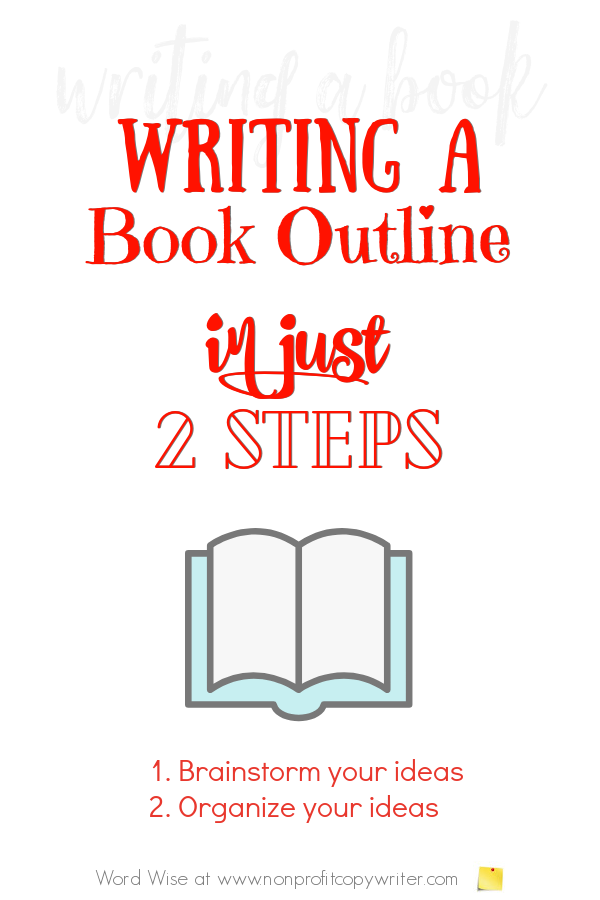Save Time: Get 5 Simple Writing Tips
you can put to use in 10 minutes
Writing a Book Outline: It's Easier Than You Think
Award-winning writer Kathy Widenhouse has helped hundreds of nonprofits and writers produce successful content , with 750K+ views for her writing tutorials. She is the author of 9 books. See more of Kathy’s content here.
Updated 7.1.25
Writing a book outline is easier than you think.
Outlining a nonfiction book is a distinctively different process when compared with fiction. A novel or short story centers around character development, conflict, and resolution. A nonfiction book, on the other hand, solves a problem for your reader.
Which makes writing your nonfiction book outline simple. Just organize your ideas to solve the problem. That’s it.
When you’re writing a book outline, you don’t take rabbit trails into extra research. You don’t ponder which verb is better in which sentence. You don’t even decide what ideas to keep and what to throw out. (That comes later).
Writing a book outline is my favorite part of the book-writing process. It’s fun and energizing as ideas flow. And it gives you a pop of momentum to get started writing your book.
But first …
Is writing a book outline really necessary?
No. Writing a book outline isn’t strictly necessary—many successful authors have written without one—but I recommend it, especially for nonfiction and structured fiction.
- A book outline clarifies your big idea. An outline forces you to define what your book is about and why it matters. It helps you avoid the common trap of rambling or losing focus.
- A book outline saves time later. Writing a book is a long haul. Without a roadmap, it’s easy to get stuck, double back, or write thousands of words you later cut. An outline helps you stay on track.
- A book outline helps with structure. Books (especially nonfiction) need a logical flow. An outline helps ensure your ideas build on each other and make sense to readers.
- A book outline makes research easier. As you create your book outline, you find out additional content you need for each chapter – which lets you target your research later on.
- A book outline makes your pitch or proposal easier. Your outline is part of your book proposal when you seek a publisher or agent. Even self-published authors benefit from writing a book outline when marketing your book or creating a launch plan.
- A book outline breaks the writing into manageable parts. Instead of writing a whole book, you’re writing one section at a time, which is far less overwhelming.
Even a “flexible outline” – a list of chapter titles, main points, or a few guiding questions – helps you stay focused as you write but leaves room for creativity.
Writing a book outline takes just 2 steps
Writing an outline for your nonfiction book is not hard if you break down the process into just two smaller steps.
Step #1: Brainstorm your ideas
The first step is to get your ideas for your book out of your brain and onto paper. By doing a brain dump, you avoid a massive cranial traffic jam.
This process may take a few days or weeks. The length of time differs from writer to writer and from book to book. The point is to get started and then stick with it.
There are a number of ways you can go about extracting your ideas for your book.
- Use a legal pad and a pencil to jot down your ideas.
- Record individual thoughts on 3 x 5 notecards.
- Create a new computer file.
- Start a notebook in Evernote.
- Use a mind map – a drawing with one central idea and branches with sub-topics to show how concepts are related.
- Check out writing software like Scrivener and ProWritingAid.
I like to go old school because I like to get my hands on things and see the big-picture view, but many writers find online gadgetry useful. Your technique doesn’t matter.
Whatever method you choose, start by writing down every idea you think you may want to address in your book. This is not the time to sort through and eliminate, but rather to gather and record. Be sure to include:
- Points about your topic. You will evaluate these later and choose which are key ideas to convert to chapter themes and which can be used as supporting material.
- Supporting content: Record information about your book topic that you’d like to mention or expand on with more research. Don’t worry if you don’t have detailed information at this point. Instead, make a note of the point and where you found it, or where to look to learn more.
- Stories and illustrations. Jot down personal stories, interesting statistics, engaging quotes, or unique facts that you can use as illustrations or as hooks for each chapter – much as you’d choose hooks for writing an article or blog post.
- Takeaways. What are the applications that you’d like your readers to understand? Make a note of those lessons or principles.
As you brainstorm, record just as much as you need. You may be tempted to head off on a rabbit trail of research or even create content. Resist this urge. You can flesh out the material later. For now, you simply need to make a note of your ideas, even ones that seem out of sync or far-fetched for your overall topic.
Remember: the point of brainstorming is not to create a finished product. The point is to get your information out of your brain so you can put it in a semblance of order.
When you cannot think of any other ideas you want to include in your book, then move on to organizing ideas. Other content will surface during the writing process. But at this point, give yourself permission to move on from brainstorming.
2. Organize your ideas
Once you’ve gathered ideas and concepts – likely a lot of them – you need to organize them.
One of the easiest ways to do this is to record each idea you gathered onto an individual index card. Each principle, point, story, statistic, and takeaway.
Then set aside an afternoon, lay out the cards on your dining room table or your living room floor, and begin to sort.
Sort into topics
Look for patterns or ideas that belong together. Give the set of cards a name. You can change the name later, but for now you have chapter names.
Sort into an order
Once your ideas are clumped into groups, you need to put them in order. Sometimes the outline order is evident right away. If not, ask yourself two questions:
- If I wasn’t familiar with this topic or if the topic was confusing to me, how would I want it explained?
- What would I need to know first?
The answer to one or both of those questions can give you an indication about how to organize chapters. You can also use this set of 6 outline formats to consider when writing a book outline.
Writing a book outline reveals your next step
A key to writing a book outline is to recognize two important truths from the get-go:
- An outline is not the finished product.
- An outline gives you a framework for your book-writing project.
By writing your book outline, you …
- Clarify your book’s main point.
- Figure out the strongest argument to make that point.
- Discover where you need more research.
You can tweak and adjust all of that along the way. But your book outline gets you off to a terrific start.
Writing a book outline starts with one step
Once you’ve got a big-picture framework for your book, the next step is to organize the content in each chapter.
Then you’ll write your book one chapter at a time. And soon, you’ll have a book manuscript in your hands.
You start your book with one step -- by writing down one idea. Then another. Soon, those ideas will snowball. And before long, you’ll be ready to look for patterns and organize your thoughts … and you’ll have an outline for your book.
More Book Writing Tips
Getting Started Writing a Book ...
How to Use a Personalized Book Writing Plan to Get Your Book Done ...
5 Places to Find Book Ideas ...
How To Get Started Writing a Book With a Brain Dump ...
Test Your Book Idea with These 4 Questions ...
Write an Article or Write a Book? Here’s How to Decide ...
Tips on Writing a Book (Before You Get Started Writing) ...
Create a Chapter Outline for Writing a Book Using This Template ...
Why You Should Write an eBook: 5 Reasons to Consider It ...
6 Tips for Writing Good Copy for Your Book Jacket ...
Ebook Writing Tips: What’s the Best Book Word Count for eBooks?
Writing eBooks: Frequently Asked Questions ...
See more tips for Writing a Book on my Pinterest board...
As an Amazon Associate I earn from qualifying purchases.
Share This Page

Named to 2022 Writer's Digest list
BEST GENRE/NICHE WRITING WEBSITE


Stop Wasting Time!
Grab your exclusive FREE guide, "5 Simple Writing Tips You Can Put to Use in 10 Minutes or Less"














